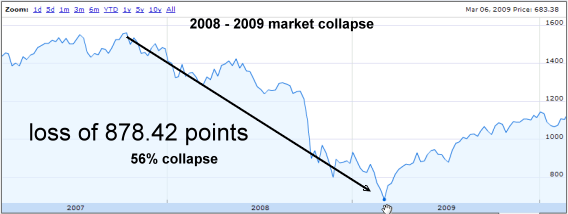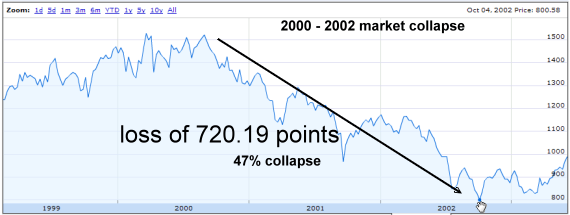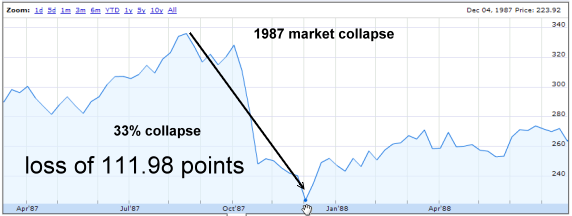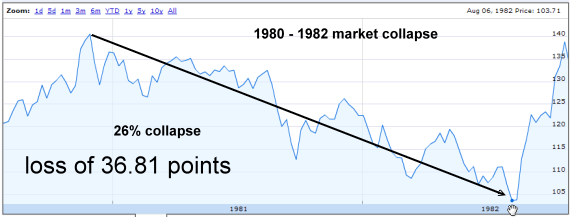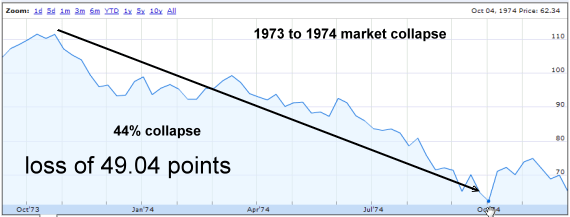Bear Market Defined
A bear market should never be confused with a correction. Corrections can be severe but bear markets are far worse. A bear market is a period in time when the price of securities fall. There is usually widespread pessimism and negative sentiment grows as the bear market lingers. Bear markets normally see enormous price drops and as prices fall, investors become even more pessimistic and normally end up selling stocks at even lower prices.
Secular Bear Market
A secular bear market is a long period of many years where markets are influenced by global events such as wars such as World War Two, government policies such as the coldwar or economic conditions such as a world depression.
They witness the rise and fall of stocks over many years but in the end see the overall collapse of stocks to very low levels.
Just as a secular bull market can have short term bears within it, secular bear markets have short term bull markets within them. However during a secular market, the overall trend reasserts itself and will continue until its eventual conclusion.
Many people believe that the S&P has been in a secular bear market since 2000. During this period the market has seen two large bull markets and two severe bears. However if the secular bear trend is indeed inplace, then eventually markets will head much lower before concluding the trend and commencing a new secular bull market. Many analysts today who believe the markets are in a secular bear, believe that this secular bear could have 10 or 15 more years left.
Spotting A Bear Market
Usually a drop of 20% or more and a continuation of declining prices that lasts longer than 2 months constitutes a bear market.
How Severe Is A Bear Market
Bear Markets can easily wipe out 40% or more of an indexes value. They can wipe out much higher amounts of individual stocks. I have been investing since 1973 and had the misfortune of first starting investing just when the bear market of 1973 to 1974 got underway. Below are all the major bear markets I have been through. There have also been smaller declines of less than 25%. Below are the bear markets I have experienced over the years of my investing in stocks.
The bear market of 2007 to 2009 saw losses of 56% in the market index .
Below is the chart from the S&P 500 for the bear market of 2000 to 2002. The overall market lost 47% of its value.
Below is the bear market collapse of 1987. Total loss of 33%.
Below is the bear market of 1980 to 1982 which saw a 26% loss in the overall index.
Below is the bear market of 1973 to 1974 which saw a loss of 44% in the S&P 500 index.
Does A Bear Market Affect All Stocks
It is pretty rare when all stocks are not affected in a bear market. Many stocks actually decline worse than the overall index. Some stocks which are labelled as defensive stocks sometimes do not fall as far as the overall market. Below is the chart for Walmart Stores (WMT) during the 2008 to 2009 market collapse. Walmart stock lost 25.9% versus the oveall S&P loss of 56%.
Other stocks will lose more than the index. For example below is Wells Fargo and Company (WFC) which lost 78% of its value in the 2008 to 2009 market collapse.
How Long Does A Bear Market Last
Bear Markets normally last a minimum of 6 months out to 2 or 3 years.
Picking Entry Points In A Bear Market
The most difficult aspect of a bear market is picking entry points as often the market will have a severe pullback and investors will believe that all the signs are there that the “bottom” is in for stocks. They buy hoping to have bought stocks at the low only to find that the bottom is still a long way off. Buying for trading is a touch choice in a bear market. I prefer selling naked calls in a bear market. As well if I am holding stocks long term, I normally will wait for a rally and then sell in the money covered calls to garner as much premium as I can and then watch the stock fall back again leaving my in the money covered call, out of the money and expired.
Panic
As a bear market advances in time, investors become more pessimistic. Eventually that pessimism leads to lower overall prices. Analysts also become weary of the continuing bear market and the tone of media articles and broadcasts take on very negative tones. Magazines may even write about the end of equities, which has occurred in a number of bear markets including the 1973 to 1974 collapse, 2000 to 2002 collapse and the recent 2008 to 2009 collapse.
Eventually panic will ensue as investors give up on stocks and will sell at any price driving stocks to new lows as investors flee stocks. This bear market panic is often referred to as “blood in the streets”, a favorite expression of famed investor Warren Buffett. It is at these times that some investors step in and pick up stocks at very low prices.
Whether panic is the time to buy stocks, is difficult to say. I prefer to buy after a panic and when there is a bit of a rally starting. This way if the stocks I purchase move up and then turn back down, my losses are small and sometimes I can even earn a small profit.
The VIX
Understand the VIX is an important aspect of bear markets. The VIX is an index that measures stock market volatility. As the VIX climbs in value, option premiums also climb. Bear Markets also create wider swings in stock prices and indexes. The VIX measures those swings and can assist an investor in making investments and trades.
BUYING AND SELLING IN A BEAR MARKET
One of the most obvious benefits of a bear market is the ability to earn large profits through buying puts or selling stocks short. In the past few years a number of new products have been introduced to take advantage of the downturns to earn additional capital. There is today a large list of inverse ETFs and ETNs which cover not just the markets, but almost every sector and commodity imaginable.
Inverse funds that are both 1X, 2X and even 3X are designed to increase in value as the market, sector or commodity falls. When the market falls these funds increase, earning substantial returns. The 2X and 3X funds provide twice and three times the fall in the market. These funds can provide huge gains and huge losses so they are best used for short term trades only. Below is a list of Inverse ETFs and Inverse ETNs as of August 2011. There are more available, but this is a fairly extensive list.
Inverse ETFs
•BGZ – Direxion Daily Large Cap Bear 3X Shares ETF
•BIS – UltraShort NASDAQ Biotechnology ETF
•BRIS – Direxion Daily BRIC Bear 2x Shares ETF
•BXDB – Barclays Short B Leveraged Inverse S&P 500 Total Return ETN
•COWS – Direxion Daily Agribusiness Bear 3x Shares ETF
•DDG – Short Oil & Gas ProShares ETF
•DLBS – iPath US Treasury Long Bond Bear ETN
•DMM – MacroShares Housing Down ETF
•DNO – United States Short Oil ETF
•DOG – Short Dow30 ProShares ETF
•DOY – MacroShares $100 Oil Down ETF
•DPK – Direxion Daily Devloped Markets Bear 3X Shares ETF
•DSTJ – JP Morgan 2X Short US Long Treasury Futures ETN
•DSXJ – JP Morgan 2X Short US 10 Year Treasury Futures ETN
•DUG – UltraShort Oil & Gas ProShares ETF
•DUST – Direxion Daily Gold Miners Bear 2x Shares ETF
•DXD – UltraShort Dow30 ProShares ETF
•EDZ – Direxion Daily Emerging Markets Bear 3X Shares ETF
•EEV – UltraShort MSCI Emerging Markets ProShares ETF
•EFU – UltraShort MSCI EAFE ProShares ETF
•EFZ – Short MSCI EAFE ProShares ETF
•ERY – Direxion Daily Energy Bear 3X Shares ETF
•EUM – Short MSCI Emerging Markets ProShares ETF
•EUO – ProShares UltraShort Euro ETF
•EWV – UltraShort MSCI Japan ProShares ETF
•FAZ – Direxion Daily Financial Bear 3X Shares ETF
•FXP – UltraShort FTSE/Xinhua China25 Proshares ETF
•GASX – Direxion Daily Natural Gas Related Bear 2X Shares ETF
•GLL – UltraShort Gold ProShares ETF
•INDZ – Direxion Daily India Bear 2x Shares ETF
•KRS – Short KBW Regional Banking ETF
•LHB – Direxion Daily Latin America 3x Bear Shares ETF
•MATS – Direxion Daily Basic Materials Bear 3X Shares ETF
•MWN – Direxion Daily Mid Cap Bear 3X Shares ETF
•MYY – Short MidCap400 ProShares ETF
•MZZ – UltraShort MidCap400 ProShares ETF
•PSQ – Short QQQ ProShares ETF
•PST – ProShares UltraShort 7-10 Year Treasury ETF
•QID – UltraShort QQQ ProShares ETF
•QLD – Ultra QQQ ProShares ETF
•REK – ProShares Short Real Estate ETF
•RETS – Direxion Daily Retail Bear 2X Shares ETF
•REW – UltraShort Technology ProShares ETF
•RSW – Rydex Inverse 2x S&P 500 ETF
•RUSS – Direxion Daily Russia Bear 3x Shares ETF
•RWM – Short Russell2000 ProShares ETF
•RXD – UltraShort Health Care ProShares ETF
•SAGG – Daily Total Bond Market Bear 1x Shares ETF
•SBB – ProShares Short S&P SmallCap600 ETF
•SBM – ProShares Short Basic Materials ETF
•SCC – ProShares UltraShort Consumer Services ETF
•SCO – ProShares UltraShort DJ-AIG Crude Oil ETF
•SDD – ProShares UltraShort SmallCap600 ETF
•SDK – ProShares UltraShort MidCap Growth ETF
•SDOW – UltraPro Short Dow 30 ETF
•SDP – ProShares UltraShort Utilities ETF
•SDS – ProShares UltraShort S&P500 ETF
•SEF – Short Financials ProShares ETF
•SFK – ProShares UltraShort Russell1000 Growth ETF
•SH – ProShares Short S&P500 ETF
•SICK – Direxion Daily Healthcare Bear 3X Shares ETF
•SIJ – ProShares UltraShort Industrials ETF
•SJB – ProShares Short High Yield ETF
•SJH – ProShares UltraShort Russell 2000 Value ETF
•SJL – ProShares UltraShort MidCap Value ETF
•SKF – ProShares UltraShort Financials ETF
•SKK – ProShares UltraShort Russell2000 Growth ETF
•SMDD – UltraPro Short Mid-Cap 400
•SMN – ProShares UltraShort Basic Materials ETF
•SOXS – Direxion Daily Semiconductor Bear 3x Shares ETF
•SPXU – ProShares Ultra Pro Short S&P 500 ETF
•SQQQ – UltraPro Short QQQ ETF
•SRS – ProShares UltraShort Real Estate ETF
•SRTY – UltraPro Short Russell 2000 ETF
•SSG – ProShares UltraShort SemiConductor ETF
•SZK – ProShares UltraShort Consumer Goods ETF
•TBF – ProShares Short 20+ Year Treasury ETF
•TBT – ProShares UltraShort 20+ Year Treasury ETF
•TBX – Short 7-10 Year Treasury ETF
•TBZ – UltraShort 3-7 Year Treasury ETF
•TLL – ProShares UltraShort Telecommunications ETF
•TMV – Direxion Daily 30-year Treasury Bear 3x Shares ETF
•TOTS – Direxion Daily Total Market Bear 1X Shares ETF
•TPS – ProShares UltraShort TIPS ETF
•TWM – ProShares UltraShort Russell2000 ETF
•TYBS – Daily 20 Year Plus Treasury Bear 1x Shares ETF
•TYNS – Daily 7-10 Year Treasury Bear 1x Shares ETF
•TYO – Direxion Daily 10-year Treasury Bear 3x Shares ETF
•TYP – Direxion Daily Technology Bear 3x Shares ETF
•TZA – Direxion Daily SmallCap Bear 3x Shares ETF
•TWQ – ProShares UltrShort Russell 3000 Index ETF
•UDN – PowerShares US Dollar Bearish ETF
•YCS – ProShares UltraShort Yen ETF
•YXI – Proshares Short FTSE / Xinhua China 25 ETF
•ZSL – ProShares UltraShort Silver ETF
INVERSE ETNs
•AGA – PowerShares DB Agriculture Double Short ETN
•BOM – PowerShares DB Base Metals Double Short ETN
•DDP – PowerShares DB Commodity Short ETN
•DEE – PowerShares DB Commodity Double Short ETN
•DGZ – PowerShares DB Gold Short ETN
•DRR – Market Vectors Double Short Euro ETN
•DTO – PowerShares DB Crude Oil Double Short ETN
•DTUS – iPath US Treasury 2-year Bear ETN
•DTYS – iPath US Treasury 10-year Bear ETN
•DZZ – PowerShares DB Gold Double Short ETN
•EMSA – iPath Short Enhanced MSCI Emerging Markets Index ETN
•IVO – iPath Inverse January 2021 S&P 500 VIX Short-Term Futures ETN
•MFSA – iPath Short Enhanced MSCI EAFE Index ETN
•MLPS – UBS E-TRACS 1x Monthly Short Alerian MLP Infrastructure Total Return Index ETN
•ROSA – iPath Short Extended Russell 1000 TR Index ETN
•RTSA – iPath Short Extended Russell 2000 TR Index ETN
•SBND – PowerShares DB 3X Short 25+ Year Treasury Bond Exchange Traded Note
•SFSA – iPath Short Extended S&P 500 TR Index ETN
•SZO – PowerShares DB Crude Oil Short ETN
•UDNT – PowerShares DB 3x Short US Dollar Index Futures ETN
•XXV – Barclays ETN+ Inverse S&P 500 VIX Short-Term Futures ETN
•XIV – VelocityShares Daily Inverse VIX Short Term ETN
•ZIV – VelocityShares Daily Inverse VIX Mid Term ETN
BEAR MARKET – CONCLUSION
Bear markets are as natural an occurence as bull markets. They serve a vital function as they reflect the change in economic conditions and earnings of the underlying security or commodity. Bear markets are feared by many investors but through understanding them, and how they reflect the actual unfolding economic conditions an investor can take steps to not only protect themselves through such things as buying puts, but can also benefit from bear markets through purchasing inverse products and buying stocks at lower valuations.


